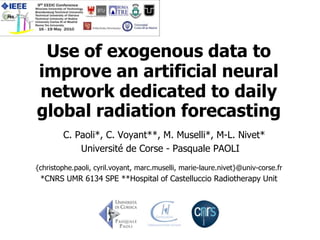2010 05-15-cpaoli-prague-eeeic final
- 1. Use of exogenous data to improve an artificial neural network dedicated to daily global radiation forecasting C. Paoli*, C. Voyant**, M. Muselli*, M-L. Nivet* Université de Corse - Pasquale PAOLI {christophe.paoli, cyril.voyant, marc.muselli, marie-laure.nivet}@univ-corse.fr *CNRS UMR 6134 SPE **Hospital of Castelluccio Radiotherapy Unit
- 2. Objectives Forecast the global radiation at daily time step using an Artificial Neural Networks (ANNs) Look at the Multi-Layer Perceptron (MLP) which has been the most used of ANNs architecture Optimize the MLP and define an ad-hoc time series preprocessing Add exogenous meteorological data to improve the predictor 9th EEEIC Conference, 16-19 May 2010, Prague, Czech Republic 2/12
- 3. Outline Data and context Methodology – Time Series Preprocessing – MLP configuration – Use of correlation criteria to add endogenous data and exogenous meteorological data at different time lags Results and discussion Conclusion and perspectives 9th EEEIC Conference, 16-19 May 2010, Prague, Czech Republic 3/12
- 4. Data and context Measured global daily radiation data from two meteorological stations equipped with standard meteorological sensors (pressure, nebulosity, etc.) – Ajaccio • 41 55’N and 8 48’E, seaside, 4 m – Bastia • 42 33’N, 9 29’E, seaside, 10 m – Mediterranean climate • hot summers with abundant sunshine and mild, dry, clear winters – Near the sea and relief nearby : 40 km from Ajaccio and 15 km from Bastia – Data from January 1998 to December 2007 Nebulosity difficult to forecast 9th EEEIC Conference, 16-19 May 2010, Prague, Czech Republic 4/12
- 5. measured data ; VC=0,539 9000 Methodology Global Radiation (W.h/m²) 8000 7000 6000 5000 4000 3000 2000 1000 0 Time series 1 48 95 142 189 236 283 330 377 424 471 518 565 612 659 706 Time (Days) preprocessing clearness index ; VC=0,326 – Prediction of the solar 0,9 0,8 energy time series 0,7 clearness index 0,6 perturbed by the non- 0,5 0,4 0,3 stationarity of the signal 0,2 0,1 0 and the periodicity of 1 47 93 139 185 231 277 323 369 415 461 507 553 599 645 691 Time (Days) the phenomena – Use of a stationary clearness index, with mobil average and periodic coefficients ; VC=0,323 method to increase the detrended data (no unit) 1,2 1 prediction quality, based 0,8 0,6 on the clear sky model 0,4 0,2 0 1 47 93 139 185 231 277 323 369 415 461 507 553 599 645 691 Time (Days) 9th EEEIC Conference, 16-19 May 2010, Prague, Czech Republic 5/12
- 6. Input windows xt Methodology MLP configuration t – Choice of the hidden layer Sliding window technique number and activation function – Choice of the time lag numbers Xt-1 Xt for the endogenous input Xt-2 Error – Choice of the time lag numbers Xt-3 for the exogenous meteorological inputs ˆ Xt • Daily Pressure Variation • Wind Direction, Humidity, Xt-p • Insulation, Nebulosity, • Precipitation, Mean Pressure • Min-Max-Mean Temperatures 1 hidden layer, hyperbolic tangent • Night Temperature, Wind Speed (hidden) and linear (output), Levenberg-Marquardt. 9th EEEIC Conference, 16-19 May 2010, Prague, Czech Republic 6/12
- 7. Methodology Use of correlation criteria to efficiently add endogenous data and exogenous meteorological data at different time lags – Use of the Partial Auto Correlation Factor (PACF) in the endogenous case – Use of the Pearson correlation coefficient method to select the exogenous variables 9th EEEIC Conference, 16-19 May 2010, Prague, Czech Republic 7/12
- 8. Methodology Partial Auto Correlation Function : PACF – Plays an important role in time series analysis – Allows to identify the extent of the time lag in an autoregressive model On figure, we can see the – We have used PACF to need to use St, St-1, St-2 determine the best time and St-3 as input of the lags for the endogenous MLP to predict St+1. input of the MLP 9th EEEIC Conference, 16-19 May 2010, Prague, Czech Republic 8/12
- 9. Methodology humidity Pearson correlation – Determines the extent to nebulosity which values of two variables are "proportional" to each other – Choice of a threshold sunshine R = 20% duration On figure, we can see that a threshold R = 20% implies that the time lag 1 is sufficient for humidity, nebulosity and sunshine duration 9th EEEIC Conference, 16-19 May 2010, Prague, Czech Republic 9/12
- 10. Results and discussion The use of exogenous data generates a decrease of nRMSE between 0.5% and 1% for the both studied locations – On the site of Bastia, the use of the exogenous data on PMC inputs increases a little the prediction quality : only 0.5% – At Ajaccio, the nRMSE is improved by 1% The RMSE is decreased by 20 Wh/m²/day (Bastia) and 52 Wh/m²/day (Ajaccio) 9th EEEIC Conference, 16-19 May 2010, Prague, Czech Republic 10/12
- 11. Conclusion and perspectives We have proposed in this paper to study the contribution of exogenous meteorological data to an optimized MLP neural network The next step of our work will be to study the hourly time step Verify that the adding of exogenous data can increase the accuracy when the time step of time series decreases 9th EEEIC Conference, 16-19 May 2010, Prague, Czech Republic 11/12
- 12. Thank you for your attention. Questions?
Editor's Notes
- 1 hidden layer, the activation function are hyperbolic tangent (hidden) and linear (output), the learning algorithm is the Levenberg-Marquardt model (with max fail parameter equal to 5, μ decreases and increases respectively to 0.1 and 0.001, and goals equal to zero), the normalization is done between 0 and 1; the ratio of train, validation and test periods represent respectively 80%, 10% and 10%. We have learned the ANN during the 8 first years and we have computed the global solar radiation during the 2 last years.

